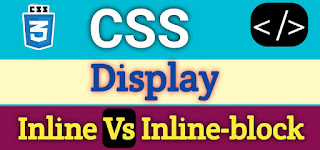1. CSS display inline
In this tutorial, we focus on one of the most common CSS display property values which is display: inline.
when you set an inline value for your display property, it uses only the required width. That means the flow of elements doesn't break or they do not begin in a new line.
Some Inline Elements
you can see some inline elements below.
- <a>
- <img>
- <code>
- <cite>
- <em>
- <b>
- <strong>
- <button>
- <input> and so on.

Example
<!DOCTYPE html> <html> <head> <title></title> <style type="text/css"> #p3{ display: inline; color: blue; } </style> </head> <body> <p id="p3">The inline display</p> <p id="p3">value display all</p> <p id="p3">element in inline with out break.</p> </body> </html>
The inline display
value display all
element in inline with out break.
<!DOCTYPE html> <html> <head> <title></title> <style type="text/css"> #p3{ display: inline; color: blue; } </style> </head> <body> <p id="p3">The <em>inline display</em> </p> <p id="p3">value display all</p> <p id="p3">element in inline <strong>with out break.</strong> </p> </body> </html>
The inline display
value display all
element in inline with out break.
2. CSS Display inline-block
Inline-block value is similar to inline value but you can adjust the height, width, margin, and padding in inline-block. It is commonly used to construct navigation bars.
Example
<!DOCTYPE html> <html> <head> <title></title> <style type="text/css"> .nn{ background-color:#330000; text-align: left; } .nn li{ display: inline-block; font-size: 20px; text-decoration: none; padding-left: 10px; padding-right: 10px; color: white; width: 75px; } </style> </head> <body> <ul class="nn"> <li>Home</li> <li>About</li> <li>Contact</li> </ul> </body> </html>



0 Comments